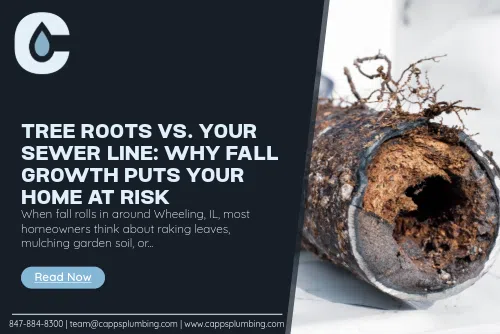When fall rolls in around Wheeling, IL, most homeowners think about raking leaves, mulching garden soil, or reseeding with grass seed. But below the surface, something else is happening that can quietly cause major plumbing trouble. Tree roots are making their final seasonal push for water and nutrients before winter. If your sewer lines are nearby, those roots may target them as an easy source of moisture.
This seasonal growth surge often leads to clogged drains, backups, or even broken sewer pipes. That’s where Capps Plumbing & Sewer comes in. For decades, our team has helped local homeowners protect their sewer systems with services like tree root removal, hydrojetting, and trenchless sewer repair. By understanding how root systems behave, spotting warning signs early, and calling in professionals you can trust, you’ll prevent costly damage and keep your home’s plumbing running smoothly all season long.
Why Tree Roots Target Sewer Lines in Fall
Roots are designed to help plants seek out water. In the fall, large trees shift energy toward storing nutrients for the winter. That means their larger roots and smaller feeder roots expand outward, sometimes traveling dozens of feet from the location of the tree itself. Sewer lines, especially those with older clay or cast-iron pipes, release small amounts of vapor that attract roots like a magnet.
Once roots find a tiny crack or joint, they push inside. Over time, the size of the tree roots inside your pipe can increase from a hair-like feeder to several inches in diameter, creating a living blockage. Left unchecked, these root problems can fracture pipes, collapse sections of the sewer, and even damage nearby landscaping.
Warning Signs That Roots Have Invaded Your Sewer
Many homeowners don’t realize that tree roots are inside their pipes until a big job like excavation becomes unavoidable.
But there are often early signs:
- Slow drains throughout your home, especially after rain
- Gurgling sounds from toilets or floor drains
- Strong sewer odors in the yard or basement
- Wet, mushy patches in the lawn topsoil, even without recent rain
- Frequent clogs that no amount of plunging or DIY drain cleaner seems to solve
If you notice any of these issues, it’s time to schedule a sewer camera inspection. At Capps Plumbing & Sewer, we utilize advanced camera and location services to pinpoint the exact size of the root problem, the location of the tree impact, and determine whether trenchless repair or full excavation is necessary.
Why DIY Tree Root Removal Rarely Works
It’s tempting to think about tackling root invasion the same way you’d handle a tree stump removal or yard project. After all, a shovel, spade, or even an axe can help with small roots in the garden.
But sewer pipes are different.
- Rock salt or Epsom salt is sometimes suggested online as a root killer. While they may temporarily dehydrate roots, they can also damage your sewer pipe materials and nearby garden soil.
- Using herbicides without professional guidance risks harming your entire living tree, surrounding plants, and even contaminating groundwater.
- Renting a stump grinder or grinder designed for tree stump removal won’t work inside a pipe. Sewer line obstructions require specialized plumbing equipment.
The most effective way to deal with tree root invasion is through professional services. Licensed plumbers can safely clear roots, protect your sewer line, and reduce the risk of recurring issues.
Professional Solutions for Root-Damaged Sewer Lines
Capps Plumbing & Sewer offers several proven methods to tackle root invasion. Which one is right depends on the size of the tree, the size of the root system, and how badly your sewer line is affected.
1. Sewer and Drain Cleaning
Specialized cutting blades and augers clear out surface roots inside your pipes. Think of it as pruning the root ball hidden in your sewer. While this offers relief, it may be temporary if the roots regrow.
2. Hydrojetting
For more stubborn or widespread invasions, hydrojetting uses high-pressure water streams to scour pipes clean. This method not only cuts away roots but also flushes out grease, debris, and even early signs of fungus buildup.
3. Trenchless Sewer Repair
If your sewer line has cracks caused by tree roots, trenchless methods can be used to repair it without disturbing your yard. Using lining materials and resin, we seal off entry points to prevent roots from returning.
4. Excavation Services
When large roots or collapsed pipes are involved, excavation may be unavoidable. Our team has the necessary heavy equipment, proper safety gear, and expertise to handle large-scale projects while protecting your property. Excavation can also address deeper issues caused by multiple large trees or an aging sewer system.
Prevention: Protecting Your Sewer Before Roots Win
The best way to save money on root removal is to prevent roots from invading in the first place.
Here are steps you can take:
- Know the location of your sewer line. Before planting, check how close a tree stump, sapling, or mature tree is to your pipes.
- Plant wisely. Avoid high-water-demand species near your sewer. If you’re adding landscaping, consult an arborist for advice on safe distances.
- Schedule regular maintenance. A professional sewer cleaning every 1–2 years helps prevent small surface roots from becoming a root ball that blocks your system.
- Repair leaks early. Even a small crack can draw in roots. Call a plumber if you suspect a leak, instead of patching with DIY fixes like mulch or compost over wet areas.
What This Means for Wheeling, IL Homeowners
Fall is a beautiful season in Illinois. But while you’re adding fertilizer to your compost pile or spreading fresh bark mulch, those same trees could be working underground to invade your sewer system. Ignoring it can result in higher costs later, such as blocked drains, sewage backups, or full replacement projects, which may incur an additional fee for emergency service.
By partnering with a trusted local expert like Capps Plumbing & Sewer, you gain peace of mind that your home’s plumbing is protected year-round. Our team responds quickly, offers solutions tailored to your situation, and uses safe, proven methods to restore your sewer system.
Key Takeaways
- Tree roots expand aggressively in the fall, often targeting sewer lines.
- Early warning signs include slow drains, sewer odors, and wet patches in lawn’s topsoil.
- DIY fixes, such as using rock salt or a chainsaw on exposed roots, won’t solve sewer problems.
- Professional options include tree root removal, hydrojetting, trenchless repair, and excavation.
- Regular maintenance and smart landscaping decisions reduce your long-term risk.
Call Capps Plumbing & Sewer Before Roots Take Over
If you suspect tree roots are threatening your sewer line, don’t wait until winter freezes the ground and makes repairs more complicated.
Contact Capps Plumbing & Sewer today to schedule a camera inspection or sewer cleaning. Protect your home before fall root growth causes bigger problems.






